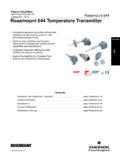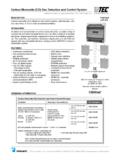Transcription of Fisher 249 Caged Displacer Sensors - Emerson
1 249 Caged Displacer of Number the the Displacer and the Displacer , Cotter Spring, StemEnd Piece, and Displacer the Displacer Rod/Driver the Torque Cage Head the Torque Tube Arm andChanging the of Process Conditions for Calibration of Fisher Level Controllers and 1. Fisher 249B sensor with 2500 ControllerW3121 3 IntroductionScope of ManualThis instruction manual includes maintenance and parts ordering information for 249 Caged a 249 sensor is usually shipped with attached controller or transmitter, this manual does not includeoperation, installation, calibration, maintenance, and parts ordering information for the controller/transmitter or forthe complete unit. For this information, refer to the appropriate controller/transmitter instruction Sensors have a rod and block shipping lock installed on each end of the Displacer to protect the Displacer in shipping, asshown in figure 2.
2 Remove these parts before installing the sensor to allow the Displacer to function not install, operate or maintain a 249 sensor without being fully trained and qualified in valve, actuator, andaccessory installation, operation, and maintenance. To avoid personal injury or property damage, it is important toInstruction ManualD200099X012249 Caged SensorsJuly 2018 Instruction ManualD200099X012249 Caged SensorsJuly 20182carefully read, understand and follow all the contents of this manual, including all safety cautions and warnings. If youhave any questions about these instructions, contact your Emerson sales office or Local Business Partner Sensors are designed to measure liquid level, interface level, or density/specific gravity inside a torque tube assembly (figure 3) and Displacer provide an indication of liquid level, interface level, or density/specificgravity.
3 The torque tube assembly consists of a hollow torque tube with a shaft welded inside it at one end andprotruding from it at the other 2. Rod and Block Shipping LockSHIPPING BLOCKLOCK NUTSHIPPING STOP RODLOCK NUTSHIPPING BLOCKSHIPPING STOP RODX1113X1114 Figure 3. Typical Caged DisplacerW1800-1W2141-1 KNIFE EDGEBEARINGTORQUE TUBEDISPLACER RODROTATABLEHEADDISPLACERCAGEI nstruction ManualD200099X012249 Caged SensorsJuly 20183 The unconnected end of the tube is sealed by a gasket and clamped rigidly to the torque tube arm, permitting theprotruding end of the shaft to twist and therefore transmit rotary motion. This allows the interior of the torque tube toremain at atmospheric pressure, thus eliminating packing and the disadvantages of packing Displacer always exerts a downward force on one end of the Displacer rod.
4 The other end of the Displacer rod restson the knife edge of the driver bearing. A keyed shaft on the bearing end of the Displacer rod fits into a socket on theoutside of the welded end of the torque tube change in liquid level, interface level, or density/specific gravity buoys up the Displacer by a force equal to the weightof the liquid displaced. Corresponding vertical movement of the Displacer results in angular movement of the displacerrod around the knife edge. Since the torque tube assembly is a torsional spring which supports the Displacer anddetermines the amount of movement of the Displacer rod for a given displacement change, it will twist a specificamount for each increment of buoyancy change. This rotation is brought through the torque tube arm by theprotruding rotary shaft. A controller or transmitter attached to the end of the rotary shaft converts the rotary motioninto varying pneumatic or electric signals.
5 Figure 4 shows how the controller or transmitter mounts on the torque otherwise noted, all NACE references are to NACE 4. Torque Tube Arm Exploded View Showing Controller or Transmitter MountingX1469 CONTROLLER OR TRANSMITTER (DLC3010/DLC3020fSHOWN)RETAININGFLANGEPO SITIONINGPLATEGASKETTORQUETUBE ARMROTARY SHAFTOUTER TUBE ENDMOUNTING HOLES ACCEPT FOUR STUDS OR CAP SCREWSDEPENDING ON CONTROLLER ORTRANSMITTERHEX NUTS OR CAP SCREWS DEPENDING ON CONTROLLER OR TRANSMITTERType Number Description 249 CL125 or 250 cast iron cage with screwed or flanged connections. 249B CL150, 300, or 600 steel cage with screwed or flanged connections. 249BF CL150, 300, or 600 cast steel or stainless steel cage with flanged connections only. Available from EmersonAutomation Solutions in Europe only. 249C CL150, 300, or 600 stainless steel cage with screwed or flanged connections.
6 249K CL900 or 1500 steel cage with flanged connections only. 249L CL2500 steel cage with flanged connections cage head on all of the 249 constructions may be rotated to any of the eight alternate positions shown in figure sizes are either NPS 1 1/2 or ManualD200099X012249 Caged SensorsJuly 20184 The Parts List section shows some 249 sizes by construction and standard Displacer lengths, and table 1 containsdisplacer and torque tube materials. However, 249 parts are available in a wide variety of materials of construction,part dimensions, and other specifications. Contact your Emerson sales office or Local Business Partner for assistance inselection of specific materials, dimensions, and 1. Displacer and Torque Tube MaterialsPartStandard MaterialOther MaterialsDisplacer304 Stainless Steel316 Stainless Steel, N10276, N04400, Plastic, and Special AlloysDisplacer Stem, Driver Bearing, Displacer Rod and Driver316 Stainless SteelN10276, N04400, other Austenitic Stainless Steels, and Special AlloysTorque TubeN05500(1)316 Stainless Steel, N06600, N102761.
7 N05500 is not recommended for spring applications above 232 C (450 F). Contact your Emerson sales office or application engineer if temperatures exceeding this limit are ServicesFor information on available courses for 249 Displacer Sensors , as well as a variety of other products, contact: Emerson Automation SolutionsEducational Services, RegistrationPhone: +1-641-754-3771 or +1800-338-8158e mail: parts are subject to normal wear and must be inspected and replaced as necessary. The frequency of inspectionand replacement depends upon the severity of service conditions. WARNINGA lways wear protective clothing, gloves, and eyewear when performing any installation operations to avoid personal injury or property damage resulting from the sudden release of pressure. Before performing anymaintenance procedure: Relieve any process pressure in the vessel where the 249 sensor is installed.
8 Drain the process liquid from the vessel. Shut off any electrical or pneumatic input to the controller or transmitter attached to the 249 sensor and vent anypneumatic supply pressure. Use caution when loosening flange bolting (key 22) or pipe plugs (key 17, 26, or 27). Remove the controller or transmitter from the torque tube arm (key 3).Before continuing with any maintenance procedure, be sure the cage (key 1) is also free of process pressure and/or caution when loosening flange bolting (key 22) or pipe plugs (key 17, 26, or 27).Before performing any maintenance procedure requiring the handling of the Displacer , inspect the Displacer (key 10) tomake sure process pressure or liquids have not penetrated the ManualD200099X012249 Caged SensorsJuly 20185 The Displacer in this unit is a sealed container.
9 If penetrated by process pressure or liquid, the Displacer may hold pressureor hazardous liquid for an extended period. A Displacer that has been penetrated by process pressure or liquid may contain: pressure as a result of being in a pressurized vessel liquid that becomes pressurized due to a change in temperature liquid that is flammable, hazardous or corrosiveSudden release of pressure, contact with hazardous liquid, fire, or explosion, which might result in personal injury orproperty damage, can occur if a Displacer that is retaining pressure or process liquid is punctured, subjected to heat, the Displacer with care. Consider the characteristics of the specific process liquid in with your process or safety engineer for any additional measures that must be taken to protect against for gaskets (keys 13 and 14), trouble symptoms peculiar to specific parts are discussed in the following sections.
10 Eachsection is specific to these parts. Regardless of location, gasket failure is indicated by leakage in the gasket area. Every time agasket is removed, replace it with a new one upon procedures below apply to all sensor types except where indicated. Key numbers used are shown in the followingillustrations:249 figure 8249B figure 9249C figure 10249K figure 11249L figure 12 Cleaning the CageProcess residue buildup in the bottom of the cage (key 1) or at the connections may restrict flow in and out of the cageor interfere with Displacer motion. Remove the cage to clean out process residue Before starting any maintenance procedure, be sure the following safety actions have been completed. Relieve process pressure in the vessel where the 249 sensor is installed. Drain the process liquid from the vessel.


















